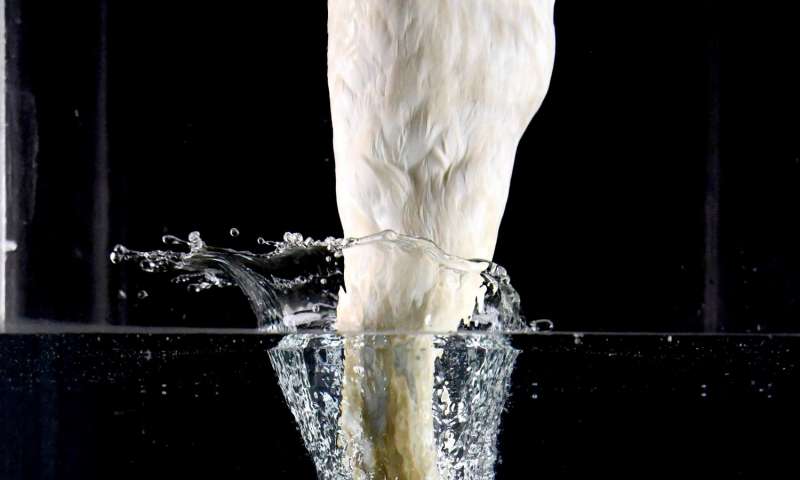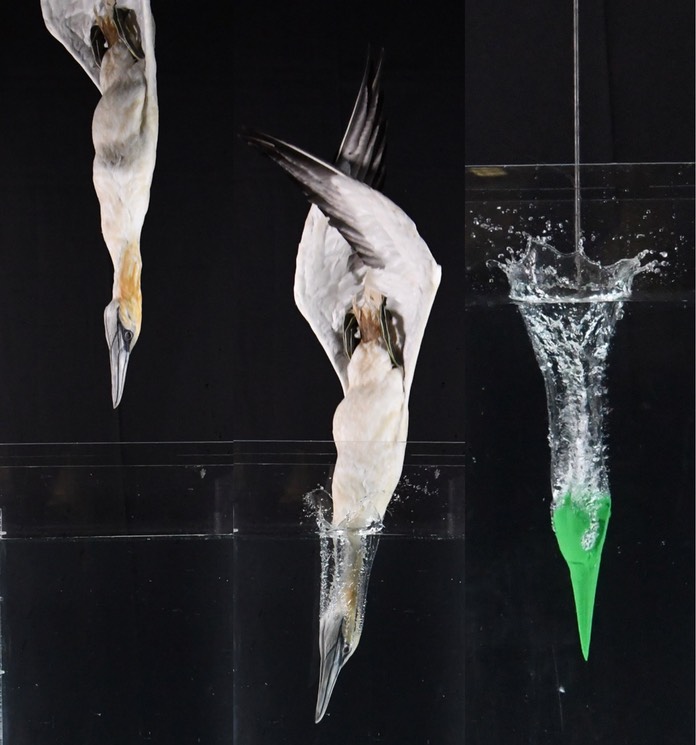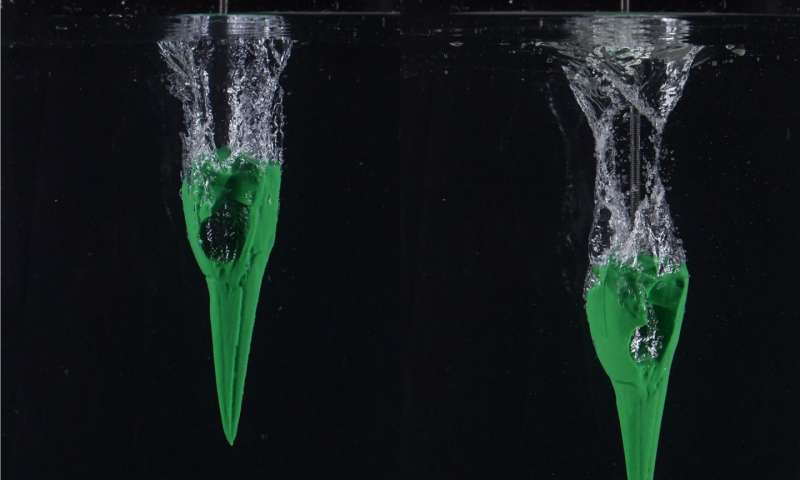Physics in the animal world: diving birds and their safety system

Some seabird species are capable of diving to great depths with a very high initial speed. Some species of birds dive from the height, plunging into the water without harm to themselves. A person, if he submerged in water at the same speed, would have received very serious injuries of internal organs and, with a high probability, would have died. But birds easily transfer fast immersion in depth. This is different, for example, booby. Olushi are large birds that freely hover over the ocean and fish and squids, diving into water from a height of 10-100 m to a depth of 25 m. The body length of adults of the Sula genus is 71–91 cm, wingspan is up to 1.5 m , weight 0.7-1.5 kg. When diving can reach speeds at the surface of the water up to 140 km / h.
How are these birds capable of this? The gannets have several defense mechanisms of the auditory and visual apparatus and the whole body. A recent study by a group of scientists from the Virginia Polytechnic Institute clarified the situation. The results were published in Proceedings of the National Academy of Sciences .
“We were wondering what happens to birds when they are immersed in water. Olushi showed an incredible result, ”says Sunny Jung, one of the team members. Researchers in the course of their work studied the biomechanics of booby during diving. They found that the bird’s head shape, neck length and neck muscle features effectively resist initial resistance and the growing pressure of the water column, preventing the negative effects of high pressure on the thin neck and the entire body of the bird. The main force acting on the bird’s head at the beginning of the dive is resistance. His booties learned to overcome without problems.
Previous studies have focused on the environmental aspects of the predatory instincts of booby. Jang and his colleagues decided to study the mechanism of diving booby in water. A group of scientists was the first to find out many details of the physics of immersion, including the structural features of the body, which allow footed boobies to feel great at great depths. Scientists have created a model of the body and neck (with muscles). Also, experts printed on a 3D printer copies of the booby skulls. The copies were made on the basis of real skulls provided by the Smithsonian Institution.
Thanks to the "printout" scientists were able to measure the forces that act on the head and neck of the bird during the dive. To further explore the possibilities of the best scientists, they created a 3D model of the head and neck of a gannet. It was decided to make the model simplified, gradually complicating the work. Head put on a flexible rubberized "neck". The whole system was then immersed several times in water, experiencing the process of diving booby. The “head” and “neck” were immersed at different depths from different angles. The artificial neck was covered with different materials with different properties. The immersion process was filmed on a high-speed camera, which helped to establish the truth.

“This is exactly what we did. They found a complex system and decided to simplify it, ”said Brian Chang from the University of Vanchington. The result of the analysis showed that, depending on the geometry of the head, a strong pressure on it can have almost no effect, and it can also seriously damage the health of the bird. Also, scientists have studied the strength of the neck, which is able to endure huge loads.
“We found that all gannets have their heads modified in a special way, which is typical of other birds of the family. This reduces the effect of the water column on the skull. As it turned out, the reason is that the booby before diving greatly reduces the neck muscles, which does not lead to the death of these birds. Reducing the muscles of the neck, booby reduce the effect of water resistance on the body.
Biomechanics allowed scientists to create models of skeletons not only the boobies mentioned in this article. "In our study, we focused on boobies and cormorants, which demonstrate true fiction when it comes to hunting by diving." It turned out that the shape of the head, the properties of the material of the neck, the speed of entry into the water are of great importance for overcoming the resistance of water. When diving the body of gannet takes an elongated shape, the bird enters the water, like an arrow shot from a bow.

The body of boobies is ideally suited for high-speed diving. It is interesting that other members of the family have the ability to dive into the water, breaking from a height and not diving.
A person, unfortunately, does not have the ability to defend himself when diving to a depth in a matter of minutes, as birds do. But many people like to dive from above. Extreme sports such as jumping from a great height - from bridges, cliffs and other high objects - are becoming more and more popular. The results of the study , obtained by scientists, will help develop recommendations for extremes that will avoid damage when entering the water column.
“We believe that our findings can be used by real high-divers, ” scientists say.
